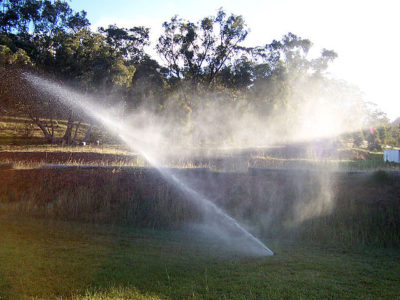Are Front Lawns Unconstitutional?
In California, They Are

Textually, this is not difficult. Article X Section 2 of the California Constitution reads:
The right to water or to the use or flow of water in or from any natural stream or water course in this State is and shall be limited to such water as shall be reasonably required for the beneficial use to be served, and such right does not and shall not extend to the waste or unreasonable use or unreasonable method of use or unreasonable method of diversion of water.
What reasonable or beneficial use does a front lawn serve? This isn’t trivial. By some serious estimates, about 50% of residential water use is used on lawns and related landscaping. And for what? What value does a front lawn serve?
I am sure that one could find something, of course. But the reasonable use doctrine does not allow a use that one could find some use for. It must be useful within context.
The California Supreme Court has been quite clear on this: simply because someone has water rights does not mean that changing conditions are irrelevant. Just the opposite. In the seminal case of Joslin v Marin Municipal Water District (1967), the Court was quite clear that water rights can and must be changed given “the increasing need for the conservation of water in this state.” (Brian Gray of the UC College of Law – San Francisco has written a helpful primer on this.). In Imperial Irrigation District v. State Water Resources Control Board (1986), the Court of Appeal held not only that changed conditions can turn a reasonable use into an unreasonable one, but that this even applies to appropriators from before 1914 (when California first legislated statewide regulation of surface water appropriation).
Front lawns are a classic postwar development of single-family zoning and 1950’s patriarchy: Dad goes to work, Mom stays home and plays with the kids on the lawn. Doesn’t happen much anymore.
And it’s worse than that, because you could easily increase density while maintaining single-family houses if you could get rid of the front lawn.
The challenge here is political of course, but even more so technical. Suppose that the State Water Resources Control Board decides that watering lawns is illegal as an unreasonable use. What would it do? There isn’t a little meter at everyone’s house that goes off depending upon use (which as I have argued before, is a big problem).
I suppose that the first step is to make a statistical estimate of the amount of water each agency uses for watering lawns, and tell agencies that within a certain amount of time, their water rights will be reduced by that amount. There will be a lawsuit on that, but SWRCB can win if they do the right analysis and make the right findings.
Then the agencies will have to do the dirty work – which could involve legislative help. The second task for them would be simply to tell residents that using your water supply to water your front lawn is forbidden. We can see how much that does: it might do quite a lot if there is adequate notice and transition time.
Then after a certain period of time, the local agency could fine people for watering their front lawns. As a technical matter, I wonder whether this would really be that difficult. There is no huge privacy interest: it’s your front lawn, after all. Drone surveillance of front lawns could be comparatively simple.

One could, of course, imagine the livid homeowner who screams: “who are to tell me I can’t have a lawn?” The response is easy. You can have a lawn: you just can’t use water — a public resource — on it. You want to have a lawn without water? In the words of the famous hydrologist Harry Callahan: Go ahead — make my day.
Yes, yes, I know I know: 1) it sounds simple on paper (pixel?) from a professor who doesn’t have to do it; and 2) agricultural unreasonable use is greater. Both true. But let’s not make the perfect the enemy of the good. And this isn’t a matter of leverage, i.e. “why should we conserve of those alfalfa farmers won’t?” It’s just good policy. Let’s do it.
Reader Comments
6 Replies to “Are Front Lawns Unconstitutional?”
Comments are closed.








California Water Code §13050(f) provides:
“Beneficial uses of the waters of the state that may be protected against quality degradation include, but are not necessarily limited to, domestic…supply;… recreation; aesthetic enjoyment;…and preservation and enhancement of… wildlife …”
Lawns fall within those categories of beneficial use. Cal. Code Regs. Tit. 23, § 660 specifically includes irrigation of lawns as “domestic use.” Lawns also provide for recreation as playgrounds, especially for families with children, and generally provide aesthetic enjoyment for property owners and their communities.
Moreover, lawns are ecological systems that provide for the preservation or enhancement of grasses, worms, insects, microbes, fungi, birds, squirrels and other wildlife. They also serve as greenspaces that capture carbon and mitigate urban heat islands.
While it may be argued that there are better ways to achieve these beneficial uses, it cannot reasonably be argued that none of these beneficial uses are provided by lawns.
Further, the amount of water usage for lawns is less than 5% of total water usage in California. Improvements to irrigation efficiency and lawn care should be achieved, but lawns should not be the scapegoat for California’s water problems.
Urban water use is closer to 10% per PPIC. And if folks in urban areas are eating food, just saying it’s ag is misleading. The statute very clearly does NOT include lawns. The regs do, but the reasonable use doctrine is not bound by them, and they can easily be changed.
I am no defender of ag water waste. Eventually we win have to stop growing unsustainable crops in the desert. But that will mean a transformation of agricultural regions. Tearing out your lawn is minor in comparison.
Lawns are ecological deserts that consume tons of fertilizers, pesticides, herbicides.in addition to wasting water. They do NOT provide any significant habitat. Argualbly they serve a private open space but front lawns are largley just decorative. A function that can be done with xeroscaping or other ecologially produce plantings.
Nice try, but no cigar!
Providing cool and beautiful natural spaces is *not* wasteful. Who gets to decide this “context?” I sure hope it isn’t lawnhaters like you.
While I am not saying everyone has to have a lawn, many people enjoy them on an aesthetic and spiritual level. Nature is not there just to be “useful.” Lawns are just another type of plant life. Humans need beauty.
And lawns can help filter water back into the ground (although there are other ways to do that too). Also, I believe they cool the neighborhood, which saves on AC, as do trees.
Meanwhile, if ag wants to get more efficient, that’s fine with me – but don’t even think about trying to pry the nuts away from me. F.e., food is much more important than building additional housing.
Very interesting approach. Taking into account the pushback noted above, I’d suggest a smaller approach, at least to start: banish the “parkway” strip between sidewalk and street. Not only does it provide little if any of the supposed benefits of front lawns, watering it is inevitably inefficient. Something like half of the water ends up on pavement. There has been some change, already, but there are many, many miles of parkways in SoCal, miles of opportunity.
In Simi Valley where I work, we have just stopped imposing drought related fines (up to $500 for repeat offenders) for irrigation outside the limit of one day per week based on odd or even address. We do have equipment and staff in place (for the most part) to determine appropriate reduced irrigation and it will be interesting to see how this develops in California in the years to come. I suspect it will be municipally addressed at local levels depending on water supplies. Thank you for interesting discussion points to be shared in our office.